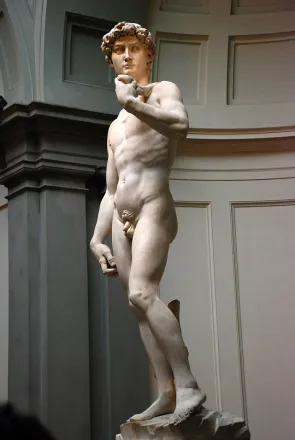David by Michelangelo
Michelangelo’s David is one of the greatest sculptures from the Italian Renaissance and probably of all time. The marble sculpture was created between 1501 and 1504 in Florence, Italy. It stands about 17.0 feet high. The sculpture depicts a the biblical hero, David. In the sculpture, David has a furrowed brow and concerned look on his face. The statue was originally unveiled outside Palazzo della Signoria, the seat of civic government in Florence, on September 8th, 1504. The eyes of the statue actually point towards Rome symbolizing the the defense of civil liberties of the Florentine Republic from rival states and the influence of the Medici family. Soon after its unveiling, Michelangelo’s David became a strong symbol for the people of Florence.
Michelangelo’s David is the perfect depiction of humanism for a couple reasons. First and foremost, Michelangelo’s David depicts rationality. The sculpture seems to show David after he has decided to fight Goliath, but before he has actually fought him. In the statue, David seems to be thinking or concerned. By this, Michelangelo can present rationality in his sculpture. David isn’t about to fight Goliath in a brutish way, but and intelligent smart way with skill and reason. If you don’t know the story of David and Goliath, David defeats Goliath, a huge man feared by all others except David, by hitting him in the head with a stone and slingshot. This shows humanism in the sculpture due the rationality that is depicted by David’s stance and facial expression. David represents humanist ideal of a man who can become a hero by his intelligence and will power. Another humanist value that David represents is civic virtue. David was created by the humanist, Michelangelo, to symbolize the defense of civil liberties of the Florentine Republic. The statue made its debut outside the Palazzo della Signoria, the place of civic government in Florence. David not only represented the ideal humanist man through rationality, but also through civic duty. In the story of David and Goliath, David is the only one to step up and fight Goliath confirming his symbolism of civic duty. Lastly, David depicts a properly proportioned human, but in a empowering way. Through David’s humanistic proportions and naked body, David showed the people of Florentine that the human body was a gift and is something that shouldn’t be hidden. Although David is large and depicts a hero, his proportions and physique are comparable to that of a common man showing that anyone can be a “hero” through will power and intelligence.
I think David by Michelangelo is one of the best works of art fromt he Renaissance. The sculpture is powerful yet very simple. It is simplistic in that it just depicts a standing man more or less. It is also simplistic in that the man is purely naked. The powerfulness comes from the interpretation and symbolism of the sculpture. Although, David is sculpted as just a standing man, his brow is furrowed and he is thinking. The grip in his right hand shows that he is just about ready to spring into action and fight Goliath. His look is concentrated, focusing on his enemy, Goliath. His naked body also conveys the naturalistic and humanistic ideas of the time. The level of detail in his body is incredible. His muscles, joints, bone structure, posture are so incredibly human-like and accurate. Even without the story behind the sculpture or the symbolism of what the sculpture represents, Michelangelo’s David is work of art purely in the attention to detail in the human body. Overall, Michelangelo’s David epitomizes the essence of humanism and is one of the greatest sculptures of all time.
Works Cited
“David (Michelangelo).” Wikipedia. Wikimedia Foundation, 06 Oct. 2014. Web. 12 June 2014. <http://en.wikipedia.org/wiki/David_%28Michelangelo%29>.
McClinton, Brian. “Michelangelo’s David.” Humanism Ireland • No 117 • July-August 2009 Humanist Masterpieces (n.d.): n. pag. Humanism Ireland. Web. 12 June 2014. <http://www.humanistni.org/filestore/file/david%20michelangelo.pdf>.
“Michelangelo, David.” Khan Academy. N.p., n.d. Web. 13 June 2014. <https://www.khanacademy.org/humanities/art-history/art-history-1500-1600-end-of-the-renaissance-and-the-reformation/high-renaissance/v/michelangelo–david–marble–1501-04–galleria-dell-accademia–florence>.

I couldn’t agree with you more than when you say that David is one of the best works of the Renaissance. I learned a lot about the statue from reading your blog post and I think it brought a new light to the sculpture that I hadn’t really thought of before, such as how he faces Rome and the associated symbolization. I considered doing my blog post on David and after reading your post on it I wish I had. There’s some really cool background to this beautiful piece and I think it would’ve been cool to learn a lot about it.
If you’re looking for a laugh, I found this video from SNL on David. Fair warning, although it’s TV appropriate, it doesn’t have the cleanest content, but its a good laugh.
[hulu id=nniynnoan1-h8dkfdgflyq width=512]
whats your name I can’t cite chicken monster 7
Did you get his name?
I got the same problem.
Pingback: The Human vs The Giant – David and Goliath – Blog of Random Oddities
Pingback: The Human vs The Giant – David and Goliath – Joseph's Blog
Thank you for your thoughts and informations !
One time I saw the legendary knowledgeable Rick Steves and his remarks about Michelangelo´s David. He also thought, that the calm youth David was a symbol of triumphing rational humanism. But he pointed also to the belief in God: The oversized supernatural hands of David show, that the power of this young man to overcome evil are not alone natural: it is the supernatural power of God and believing in God that defeats evil !